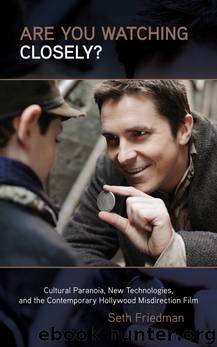Are You Watching Closely? by Friedman Seth

Author:Friedman, Seth [Friedman, Seth]
Language: eng
Format: epub
ISBN: 9781438465913
Publisher: State University of New York Press
Published: 2017-01-15T07:00:00+00:00
Figure 4.1. Diane Selwyn at Winkie’s, making arrangements with Joe, whom most fans identify as a hit man, to do something to Camilla Rhodes in Mulholland Dr.
In the “Dying Dream/Afterlife Theory,” three LOMD contributors, who adopt the usernames smapty, cuttingedgenyc, and Alfred Romo, also marshal convincing evidence to counter the “classical” interpretation. They believe that “the bulk of the film takes place after Diane has committed suicide.” For these contributors, the key to understanding the film in this manner is revealed in the pre-opening credit sequence in which, through a P.O.V. shot, a character, presumably Diane, falls to the bed to begin the dream. Significantly, in this scene, the sound is highly muffled, potentially concealing a suicidal gunshot. Following this logic, the dream thus actually begins after Diane pulls the trigger because she falls on the same bed that, in the dream, contains a rotting corpse that resembles her. The meanings of many of the film’s ambiguities and the ten clues, then, change dramatically from the “classical interpretation.” To begin, the two elderly people—Irene (Jeanne Bates) and her companion (Dan Birnbaum)—depicted in the opening jitterbug sequence and later accompanying Diane when she first arrives in L.A., can now be understood as representing “Diane’s guardian angels” because they reappear in her apartment just before she shoots herself. Similarly, club Silencio is transformed into a depiction of hell, which explains why the film ultimately returns there after Diane sees her own suicide occur. In fact, its status as hell explains why virtually all of the club’s performers, such as the magician (Richard Green) and emcee (Geno Silva), who also appears as the manager of the seedy Park Hotel, are either dressed in red or have a demonic appearance. It also reveals why the red-clad Rebekah Del Rio apparently dies onstage. For those skeptical about this interpretation, the authors present a freeze-frame of an image that only appears for a fleeting moment immediately before Betty and Rita get into the cab that takes them to club Silencio, containing a flyer attached to a telephone poll that reads in small letters “Hollywood is” and in big letters “HELL.” This plausible alternative explanation is thus bolstered by DVD technology because it enables viewers to control the image in such a fashion. Moreover, evidence to support this theory is effectively and easily communicated on the web, which allows users who possess even a little technological knowledge the ability to distribute text juxtaposed with images to a wide audience.
Like many other contributors to LOMD, the proponents of the “Dying Dream/Afterlife” theory also rely heavily on their knowledge of Lynch’s authorial tendencies and their ability to spot intertextual references to buttress their interpretation. To wit, as Camilla treks toward downtown L.A. after she survives the attempt on her life in the back of the limo, the camera tilts up to reveal that she has reached Sunset Boulevard. As the authors of this theory note, that street name is also the title of a famous 1950 Hollywood film that is “narrated by a person who is already dead” that “tells us how he came to be killed.
Download
This site does not store any files on its server. We only index and link to content provided by other sites. Please contact the content providers to delete copyright contents if any and email us, we'll remove relevant links or contents immediately.
The Kite Runner by Khaled Hosseini(5088)
Gerald's Game by Stephen King(4584)
Dialogue by Robert McKee(4326)
The Perils of Being Moderately Famous by Soha Ali Khan(4171)
The 101 Dalmatians by Dodie Smith(3455)
Story: Substance, Structure, Style and the Principles of Screenwriting by Robert McKee(3399)
The Pixar Touch by David A. Price(3369)
Confessions of a Video Vixen by Karrine Steffans(3247)
How Music Works by David Byrne(3191)
Fantastic Beasts: The Crimes of Grindelwald by J. K. Rowling(2996)
Harry Potter 4 - Harry Potter and The Goblet of Fire by J.K.Rowling(2993)
Slugfest by Reed Tucker(2946)
The Mental Game of Writing: How to Overcome Obstacles, Stay Creative and Productive, and Free Your Mind for Success by James Scott Bell(2847)
4 - Harry Potter and the Goblet of Fire by J.K. Rowling(2657)
Screenplay: The Foundations of Screenwriting by Syd Field(2576)
The Complete H. P. Lovecraft Reader by H.P. Lovecraft(2514)
Scandals of Classic Hollywood: Sex, Deviance, and Drama from the Golden Age of American Cinema by Anne Helen Petersen(2467)
Wildflower by Drew Barrymore(2446)
Robin by Dave Itzkoff(2387)
